Application of High-Performance Liquid Chromatography with Fluorescence Detection for Non-Polar Heterocyclic Aromatic Amines and Acridine Derivatives Determination in Pork Loin Roasted in a Roasting Bag
Abstract
1. Introduction
2. Materials and Methods
2.1. Reagents and Materials
2.2. Dried Fruits
2.3. Meat Roasted in an Electrical Oven with the Use of Roasting Bags
2.4. Extraction of Carbolines and Azaarenes from Meat
2.5. Determination of Carbolines and Azaarenes by HPLC with Fluorescence Detection (FLD)
2.6. Identification of Azaarenes by Gas Chromatography—Mass Spectrometry (GC-MS)
2.7. Statistical Analysis
3. Results and Discussion
3.1. Determination of Carbolines by HPLC-FLD
3.2. Determination of Azaarenes by HPLC-FLD
3.3. Carbolines Concentration in Meat Samples
3.3.1. Effect of Dried Fruits on β-Carbolines Concentration
3.3.2. Effect of Dried Fruits on δ-, γ-, and α-Carbolines Concentration
3.4. Azaarenes in Meat Samples from the Dishes Prepared with and without Vegetable Additives
4. Conclusions
Author Contributions
Funding
Institutional Review Board Statement
Informed Consent Statement
Data Availability Statement
Conflicts of Interest
References
- Sobral, M.M.; Cunha, S.C.; Faria, M.A.; Ferreira, I.M. Domestic cooking of muscle foods: Impact on composition of nutrients and contaminants. Compr. Rev. Food Sci. Food Saf. 2018, 17, 309–333. [Google Scholar] [CrossRef] [PubMed]
- Pogorzelska-Nowicka, E.; Kurek, M.; Hanula, M.; Wierzbicka, A.; Półtorak, A. Formation of carcinogens in processed meat and its measurement with the usage of artificial digestion—A review. Molecules 2022, 27, 4665. [Google Scholar] [CrossRef]
- Rivera, L.; Curto, M.J.C.; Pais, P.; Galceran, M.T.; Puignou, L. Solid-phase extraction for the selective isolation of polycyclic aromatic hydrocarbons, azaarenes and heterocyclic aromatic amines in charcoal-grilled meat. J. Chromatogr. A 1996, 731, 85–94. [Google Scholar] [CrossRef]
- Zapico, A.; Ruiz-Saavedra, S.; Gómez-Martín, M.; de los Reyes-Gavilán, C.G.; González, S. Pilot study for the dietary assessment of xenobiotics derived from food processing in an adult Spanish sample. Foods 2022, 11, 470. [Google Scholar] [CrossRef] [PubMed]
- Alaejos, M.S.; Afonso, A.M. Factors that affect the content of heterocyclic aromatic amines in foods. Compr. Rev. Food Sci. Food Saf. 2011, 10, 52–108. [Google Scholar] [CrossRef]
- Gibis, M. Heterocyclic aromatic amines in cooked meat products: Causes, formation, occurrence, and risk assessment. Compr. Rev. Food. Sci. Food. Saf. 2016, 15, 269–302. [Google Scholar] [CrossRef]
- Lu, F.; Kuhnle, G.K.; Cheng, Q. The effect of common spices and meat type on the formation of heterocyclic amines and polycyclic aromatic hydrocarbons in deep-fried meatballs. Food Control 2018, 92, 399–411. [Google Scholar] [CrossRef]
- Jamali, M.A.; Wang, Z.; Zhu, Y.; Zhang, Y. Novel water–oil mixed frying: Fried oil quality and the formation of heterocyclic amines and trans fatty acids in fried duck. Foods 2022, 11, 626. [Google Scholar] [CrossRef]
- Guo, X.; Zhang, Y.; Qian, Y.; Peng, Z. Effects of cooking cycle times of marinating juice and reheating on the formation of cholesterol oxidation products and heterocyclic amines in marinated pig hock. Foods 2020, 9, 1104. [Google Scholar] [CrossRef]
- International Agency for Research on Cancer (IARC). Monographs on the Evaluation of Carcinogenic Risks to Humans. In Red Meat and Processed Meat; IARC Publication: Lyon, France, 2018; Volume 114, p. 33. [Google Scholar]
- Sugimura, T.; Wakabayashi, K.; Nakagama, H.; Nagao, M. Heterocyclic amines: Mutagens /carcinogens produced during cooking of meat and fish. Cancer Sci. 2004, 95, 290–299. [Google Scholar] [CrossRef]
- Nadeem, H.R.; Akhtar, S.; Ismail, T.; Sestili, P.; Lorenzo, J.M.; Ranjha, M.M.A.N.; Jooste, L.; Hano, C.; Aadil, R.M. Heterocyclic Aromatic Amines in Meat: Formation, Isolation, Risk Assessment, and Inhibitory Effect of Plant Extracts. Foods 2021, 10, 1466. [Google Scholar] [CrossRef] [PubMed]
- Zamora, R.; Hidalgo, F.J. Formation of heterocyclic aromatic amines with the structure of aminoimidazoazarenes in food products. Food Chem. 2020, 313, 126–128. [Google Scholar] [CrossRef] [PubMed]
- Jägerstad, M.; Skog, K.; Arvidsson, P.; Solyakov, A. Chemistry, formation and occurrence of genotoxic heterocyclic amines identified in model systems and cooked foods. Z. Lebensm. Unters. Forsch. 1998, 207, 419–427. [Google Scholar] [CrossRef]
- Chen, X.; Jia, W.; Zhu, L.; Mao, L.; Zhang, Y. Recent advances in heterocyclic aromatic amines: An update on food safety and hazardous control from food processing to dietary intake. Compr. Rev. Food Sci. Food Saf. 2020, 19, 124–148. [Google Scholar] [CrossRef]
- Weiss, I.M.; Muth, C.; Drumm, R.; Helmut, O.K.K. Thermal decomposition of the amino acids glycine, cysteine, aspartic acid, asparagine, glutamic acid, glutamine, arginine and histidine. BMC Biophys. 2018, 11, 2. [Google Scholar] [CrossRef]
- Dong, H.; Xian, Y.; Li, H.; Bai, W.; Zeng, X. Potential carcinogenic heterocyclic aromatic amines (HAAs) in foodstuffs: Formation, extraction, analytical methods, and mitigation strategies. Compr. Rev. Food Sci. Food Saf. 2020, 19, 365–404. [Google Scholar] [CrossRef]
- Khan, M.R.; Busquets, R.; Azam, M. Blueberry, raspberry, and strawberry extracts reduce the formation of carcinogenic heterocyclic amines in fried camel, beef and chicken meats. Food Control 2021, 123, 107852. [Google Scholar] [CrossRef]
- Pfau, W.; Skog, K. Exposure to beta-carbolines norharman and harman. J. Chromatogr. B 2004, 802, 115–126. [Google Scholar] [CrossRef]
- Meurillon, M.; Engel, E. Mitigation strategies to reduce the impact of heterocyclic aromatic amines in proteinaceous foods. Trends Food Sci. Technol. 2016, 50, 70–84. [Google Scholar] [CrossRef]
- International Agency for Research on Cancer (IARC). Some naturally occurring substances: Food items and constituents, heterocyclic aromatic amines and mycotoxins. In Monographs on the Evaluation of Carcinogenic Risks to Humans; IARC Publications: Lyon, France, 1993; p. 56. [Google Scholar]
- Herraiz, T.; Galisteo, J. Tetrahydro-â-carboline Alkaloids Occur in Fruits and Fruit Juices. Activity as Antioxidants and Radical Scavengers. J. Agric. Food Chem. 2003, 51, 7156–7161. [Google Scholar] [CrossRef]
- Piechowska, P.; Zawirska-Wojtasiak, R.; Mildner-Szkudlarz, S. Bioactive β-Carbolines in Food: A Review. Nutrients 2019, 11, 814. [Google Scholar] [CrossRef] [PubMed]
- Liu, W.; Yang, Z. Bioactive β-Carbolines Harman and Norharman in Sesame Seed Oils in China. Molecules 2022, 27, 402. [Google Scholar] [CrossRef] [PubMed]
- Herraiz, T. Relative exposure to β-carbolines norharman and harman from foods and tobacco smoke. Food Addit. Contam. 2004, 21, 1041–1050. [Google Scholar] [CrossRef] [PubMed]
- Herraiz, T. Identification and occurrence of β-carboline alkaloids in raisins and inhibition of monoamine oxidase (MAO). J. Agric. Food Chem. 2007, 55, 8534–8540. [Google Scholar] [CrossRef]
- Herraiz, T.; Galisteo, J. Tetrahydro-β-carboline alkaloids occur in foods and biological systems act as radical scavengers and antioxidants in the ABTS assay. Free Radic. Res. 2002, 36, 923–928. [Google Scholar] [CrossRef]
- Herraiz, T. N-methyltetrahydropyridines and pyridinium cations as toxins and comparison with naturally-occurring alkaloids. Food Chem. Toxicol. 2016, 97, 23–39. [Google Scholar] [CrossRef]
- Xie, Z.; Cao, N.; Wang, C. A review on β-carboline alkaloids and their distribution in foodstuffs: A class of potential functional components or not? Food Chem. 2021, 348, 129067. [Google Scholar] [CrossRef]
- European Commission. European Commission Regulation (EU) No 835/2011 of 19 August 2011 amending Regulation (EC) No 1881/2006 as regards maximum levels for polycyclic aromatic hydrocarbons in foodstuffs. Off. J. Eur. Union. 2011, L215, 6–10. [Google Scholar]
- Bleeker, E.A.J.; Wiegman, S.; de Voogt, P.; Kraak, M.; Leslie, H.A.; de Haas, E.; Admiraal, W. Toxicity of azaarenes—A review. Rev. Environ. Contam. Toxicol. 2002, 173, 39–84. [Google Scholar]
- International Agency for Research on Cancer (IARC). Polynuclear Aromatic Compounds, Part 1: Chemical, Environmental and Experimental Data. In Monographs on the Evaluation of Carcinogenic Risks to Humans; IARC Publications: Lyon, France, 1983; Volume 32, pp. 4–5. [Google Scholar]
- International Agency for Research on Cancer (IARC). Bitumens and Bitumen Emissions, and some N- and S-Heterocyclic Polycyclic Aromatic Hydrocarbons. In Monographs on the Evaluation of Carcinogenic Risks to Humans; IARC Publications: Lyon, France, 2013; Volume 103, pp. 221–271. [Google Scholar]
- Sharma, R.K.; Chan, K.G.; Hajaligol, M.R. Product compositions from pyrolysis of some aliphatic α-amino acids. J. Anal. Appl. Pyrolysis 2006, 75, 69–81. [Google Scholar] [CrossRef]
- Britt, P.F.; Buchanan, A.C.; Owens, C.V., Jr.; Skeen, J.T. Does glucose enhance the formation of nitrogen containing polycyclic aromatic compounds and polycyclic aromatic hydrocarbons in the pyrolysis of proline? Fuel 2004, 83, 1417–1432. [Google Scholar] [CrossRef]
- Grimmer, G.; Naujack, K.W. Gas chromatographic profile analysis of basic nitrogen-containing aromatic compounds (azaarenes) in high protein foods. J. Assoc. Off. Anal. Chem. 1986, 69, 537–541. [Google Scholar] [CrossRef] [PubMed]
- Szterk, A. Acridine derivatives (PANHs, azaarenes) in raw, fried or grilled pork from different origins, and PANH formation during pork thermal processing. J. Food Compos. Anal. 2015, 43, 18–24. [Google Scholar] [CrossRef]
- Janoszka, B. Heterocyclic amines and azaarenes in pan-fried meat and its gravy fried without additivities and in the presence of onion and garlic. Food Chem. 2010, 120, 463–473. [Google Scholar] [CrossRef]
- Zhao, L.; Pan, F.; Li, Y.; Hao, S.; Mehmood, A.; Wang, Y.; Wang, C. Structure characteristics of flavonoids for heterocyclic aromatic amines inhibition using quantitative structure-activity relationship modeling. J. Food Biochem. 2020, 44, 13390. [Google Scholar] [CrossRef] [PubMed]
- Cao, H.; Chen, B.-H.; Inbaraj, B.S.; Chen, L.; Alvarez-Rivera, A.; Cifuentes, A.; Zhang, N.; Yang, D.-J.; Simal-Gandara, J.; Wang, M.; et al. Preventive potential and mechanism of dietary polyphenols on the formation of heterocyclic aromatic amines. Food Front. 2020, 1, 134–151. [Google Scholar] [CrossRef]
- Lee, S.Y.; Yim, D.G.; Lee, D.Y.; Kim, O.Y.; Kang, H.J.; Kim, H.S.; Jang, A.; Park, T.S.; Jin, S.K.; Hur, S.J. Overview of the effect of natural products on reduction of potential carcinogenic substances in meat products. Trends Food Sci. Techol. 2020, 99, 568–579. [Google Scholar] [CrossRef]
- Sepahpour, S.; Selamat, J.; Khatib, A.; Manap, M.Y.A.; Razis, A.F.A.; Hajeb, P. Inhibitory effect of mixture herbs/spices on formation of heterocyclic amines and mutagenic activity of grilled beef. Food Addit. Contam. Part A Chem. Anal. Control Expo Risk Assess. 2018, 35, 1911–1927. [Google Scholar] [CrossRef]
- Kilic, S.; Oz, E.; Oz, F. Effect of turmeric on the reduction of heterocyclic aromatic amines and quality of chicken meatballs. Food Control 2021, 128, 108189. [Google Scholar] [CrossRef]
- Sabally, K.; Sleno, L.; Jauffrit, J.A.; Iskandar, M.M.; Kubow, S. Inhibitory effects of apple peel polyphenol extract on the formation of heterocyclic amines in pan fried beef patties. Meat Sci. 2016, 117, 57–62. [Google Scholar] [CrossRef]
- Tengilimoglu-Metin, M.M.; Hamzalioglu, A.; Gokmen, V.; Kizil, M. Inhibitory effect of hawthorn extract on heterocyclic aromatic amine formation in beef and chicken breast meat. Food Res. Int. 2017, 99, 586–595. [Google Scholar] [CrossRef] [PubMed]
- Keskekoglu, H.; Üren, A. Inhibitory effects of pomegranate seed extract on the formation of heterocyclic aromatic amines in beef and chicken meatballs after cooking by four different methods. Meat Sci. 2014, 96, 1446–1451. [Google Scholar] [CrossRef] [PubMed]
- Jamali, M.A.; Zhang, Y.; Teng, H.; Li, S.; Wang, F.; Peng, Z. Inhibitory effect of Rosa rugose tea extract on the formation of heterocyclic amines in meat patties at different temperatures. Molecules 2016, 21, 173. [Google Scholar] [CrossRef]
- Vitaglione, P.; Fogliano, V. Use of antioxidants to minimize the human health risk associated to mutagenic/carcinogenic heterocyclic amines in food. J. Chromatogr. B Analyt. Technol. Biomed. Life Sci. 2004, 802, 189–199. [Google Scholar] [CrossRef] [PubMed]
- Ren, X.; Li, M.; Wang, W.; Niu, X.; Xu, Q.; Zhang, R. Inhibitory Effect of Tamarix ramosissima Extract on the Formation of Heterocyclic Amines in Roast Lamb Patties by Retarding the Consumption of Precursors and Preventing Free Radicals. Foods 2022, 11, 1000. [Google Scholar] [CrossRef] [PubMed]
- Khan, M.R.; Busquets, R.; Naushad, M.; Puignou, L. Cooking with elaborate recipes can reduce the formation of mutagenic heterocyclic amines and promote co-mutagenic amines. Food Addit. Contam. Part A 2019, 36, 385–395. [Google Scholar] [CrossRef]
- Jinap, S.; Hasnol, N.D.S.; Sanny, M.; Jahurul, M.H.A. Effect of organic acid ingredients in marinades containing different types of sugar on the formation of heterocyclic amines in grilled chicken. Food Control 2018, 84, 478–484. [Google Scholar] [CrossRef]
- Jing, J.; He, Y.; Wang, Y.; Zeng, M. Inhibitory effects of Portulaca oleracea L. and selected flavonoid ingredients on heterocyclic amines in roast beef patties and Density Function Theory calculation of binding between heterocyclic amines intermediates and flavonoids. Food Chem. 2021, 336, 127551. [Google Scholar] [CrossRef]
- Khan, I.A.; Liu, D.; Yao, M.; Memon, A.; Huang, J.; Huang, M. Inhibitory effect of Chrysanthemum morifolium flower extract on the formation of heterocyclic amines in goat meat patties cooked by various cooking methods and temperatures. Meat Sci. 2019, 147, 70–81. [Google Scholar] [CrossRef]
- Neves, T.M.; da Cunha, D.T.; de Rosso, V.V.; Domene, S.M.A. Effects of seasoning on the formation of heterocyclic amines and polycyclic aromatic hydrocarbons in meats: A meta-analysis. Compr. Rev. Food Sci. Food Saf. 2021, 20, 526–541. [Google Scholar] [CrossRef]
- Bao, Y.; Zhu, Y.; Ren, X.; Zhang, Y.; Peng, Z.; Zhou, G. Formation and Inhibition of Lipid Alkyl Radicals in Roasted Meat. Foods 2020, 9, 572. [Google Scholar] [CrossRef] [PubMed]
- Śnieżek, E.; Szumska, M.; Nowak, A.; Janoszka, B. The effect of onion and garlic on non-polar heterocyclic aromatic amines (α-, β-, γ- and δ-carbolines) formation in pan-fried meat and gravy. Food Addit. Contam. Part A 2022, 39, 35–51. [Google Scholar] [CrossRef] [PubMed]
- Gross, G.A.; Grüter, A. Quantitation of mutagegnic/carcinogenic heterocyclic aromatic amines in food products. J. Chromatogr. A 1992, 592, 271–278. [Google Scholar] [CrossRef]
- Konieczka, P.; Namieśnik, J. Evaluation and Quality Control of Analytical Measurement Results, 1st ed.; PWN: Warsaw, Poland, 2019; pp. 225–300. [Google Scholar]
- Xu, Y.; Li, H.; Liang, J.; Ma, J.; Yang, J.; Zhao, X.; Zhao, W.; Bai, W.; Zeng, X.; Dong, H. High-throughput quantification of eighteen heterocyclic aromatic amines in roasted and pan-fried meat on the basis of high performance liquid chromatography-quadrupole-orbitrap high resolution mass spectrometry. Food Chem. 2021, 361, 130147. [Google Scholar] [CrossRef] [PubMed]
- Liao, G.; Xu, X.; Zhou, G. Effects of cooked temperatures and addition of antioxidants on formation of heterocyclic aromatic amines in pork floss. J. Food Process. Preserv. 2009, 33, 159–175. [Google Scholar] [CrossRef]
- Savaş, A.; Oz, E.; Oz, F. Is oven bag really advantageous in terms of heterocyclic aromatic amines and bisphenol-A? Chicken meat perspective. Food Chem. 2021, 355, 129646. [Google Scholar] [CrossRef]
- Herraiz, T. Tetrahydro-beta-carboline-3-carboxylic acid compounds in fish and meat: Possible precursors of co-mutagenic beta-carbolines norharman and harman in cooked foods. Food Addit. Contam. 2000, 17, 859–866. [Google Scholar] [CrossRef]
- Tengilimoglu-Metin, M.M.; Kizil, M. Reducing effect of artichoke extract on heterocyclic aromatic amine formation in beef and chicken breast meat. Meat Sci. 2017, 134, 68–75. [Google Scholar] [CrossRef]
- Wang, P.; Hong, Y.; Ke, W.; Hu, X.; Chen, F. Formation of heterocyclic amines in Chinese marinated meat: Effects of animal species and ingredients (rock candy, soy sauce and rice wine). J. Sci. Food Agric. 2017, 97, 3967–3978. [Google Scholar] [CrossRef]
- Jung, K.; Lee, K.; Park, J.; Dong, A.; Shin, H.S. Influence of fructooligosaccharides and garlic on formation of heterocyclic amines in fried ground beef patties. Food Sci. Biotechnol. 2010, 19, 1159–1164. [Google Scholar] [CrossRef]
- Średnicka-Tober, D.; Kazimierczak, R.; Ponder, A.; Hallmann, E. Biologically Active Compounds in Selected Organic and Conventionally Produced Dried Fruits. Foods 2020, 9, 1005. [Google Scholar] [CrossRef] [PubMed]
- Zeng, M.; Li, Y.; He, Z.; Qin, F.; Chen, J. Effect of phenolic compounds from spices consumed in China on heterocyclic amine profiles in roast beef patties by UPLC–MS/MS and multivariate analysis. Meat Sci. 2016, 116, 50–57. [Google Scholar] [CrossRef] [PubMed]
- Herraiz, T. Identification and occurrence of the bioactive β-carbolines norharman and harman in coffee brews. Food Addit. Contam. 2002, 19, 748–754. [Google Scholar] [CrossRef]
- Tsuchiya, H.; Yamada, K.; Kato, H.; Hayashi, H.; Miyazaki, T.; Hayashi, T. High-performance liquid chromatographic analysis of tetrahydro-β-carbolines in food plants. Photochem. Anal. 1995, 6, 297–301. [Google Scholar] [CrossRef]
- Herraiz, T.; Galisteo, J. Naturally-occurring tetrahydro-βcarboline alkaloids derived from tryptophan are oxidized to bioactive β-carboline alkaloids by heme peroxidases. Biochem. Biophys. Res. Commun. 2014, 451, 42–47. [Google Scholar] [CrossRef]
- Herraiz, T. Occurrence of 1,2,3,4-Tetrahydro-β-carboline-3-carboxylic Acid and 1-Methyl-1,2,3,4-tetrahydro-β-carboline-3-carboxylic Acid in Fruit Juices, Purees, and Jams. J. Agric. Food Chem. 1998, 46, 3484–3490. [Google Scholar] [CrossRef]
- Herraiz, T.; Vera, F. Occurrence, Formation from D-Fructose and 3-Deoxyglucosone, and Activity of the Carbohydrate-Derived β-Carbolines in Foods. J. Agric. Food Chem. 2021, 69, 6650–6664. [Google Scholar] [CrossRef] [PubMed]
- Śnieżek, E.; Szumska, M.; Janoszka, B. Ocena właściwości przeciwutleniających wybranych produktów roślinnych w aspekcie możliwości ich wykorzystania jako dodatków do żywności wysokobiałkowej poddawanej obróbce termicznej (in Polish); (ang. Assessing Antioxidative Properties of Selected Plant-Based Products in Terms of Their Usability as Additives to Thermally Treated High Protein Food). ŻNTJ 2016, 23, 116–126. [Google Scholar]
- Cheng, K.-W.; Wu, Q.; Zheng, Z.P.; Peng, X.; Simon, J.E.; Chen, F.; Wang, M. Inhibitory effect of fruit extracts on the formation of heterocyclic amines. J. Agric. Food Chem. 2007, 55, 10359–10365. [Google Scholar] [CrossRef]
- Herraiz, T.; Galisteo, J. Hydroxyl radical reactions and the radical scavenging activity of β-carboline alkaloids. Food Chem. 2015, 172, 640–649. [Google Scholar] [CrossRef]
- Herraiz, T.; Galisteo, J. Endogenous and dietary indoles: A class of antioxidants and radical scavengers in the ABTS assay. Free Radic. Res. 2004, 38, 323–331. [Google Scholar] [CrossRef] [PubMed]
- Tai, C.-Y.; Lee, K.H.; Che, B.H. Effects of various additives on the formation of heterocyclic amines in fried fish fibre. Food Chem. 2001, 75, 309–316. [Google Scholar] [CrossRef]
- Stacewicz-Sapuntzakis, M. Dried plums and their products: Composition and health effects-an updated review. Crit. Rev. Food Sci. Nutr. 2013, 53, 1277–1302. [Google Scholar] [CrossRef] [PubMed]
- de Carvalho, A.M.; Carioca, A.A.; Fisberg, R.M.; Qi, L.; Marchioni, D.M. Joint association of fruit, vegetable, and heterocyclic amine intake with DNA damage levels in a general population. Nutrition 2016, 32, 260–264. [Google Scholar] [CrossRef]
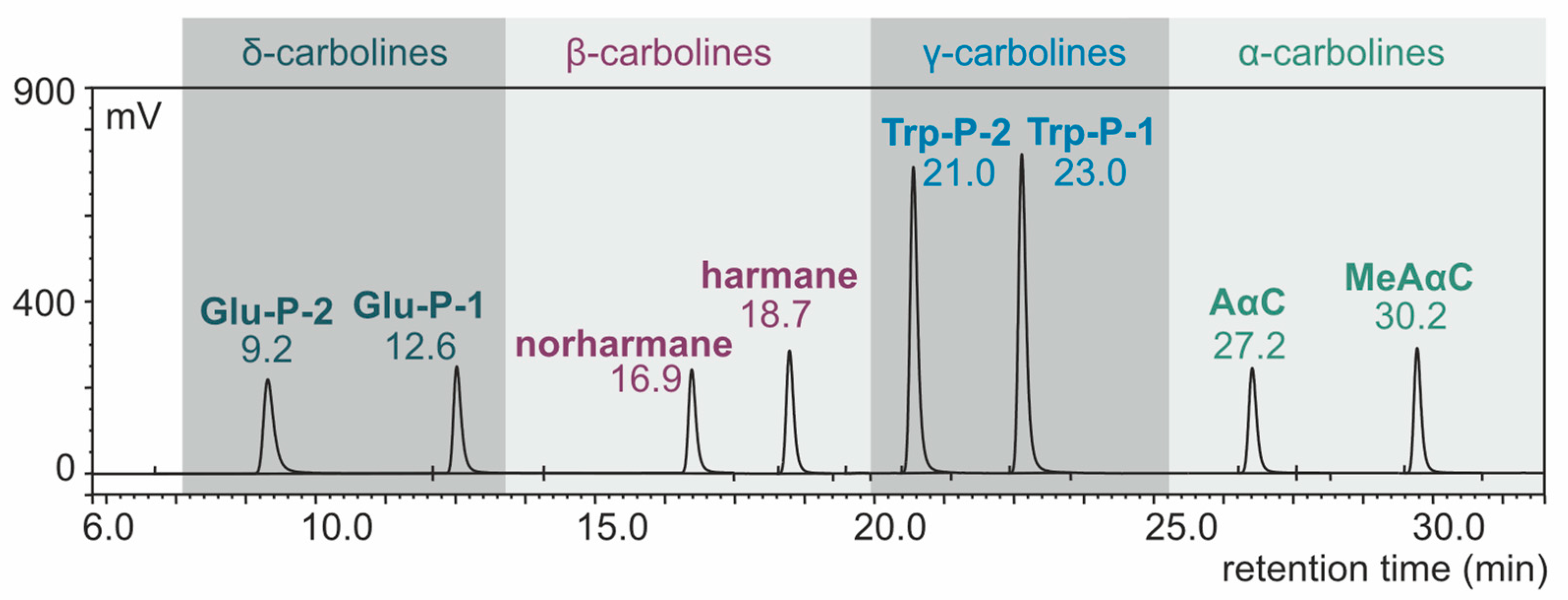
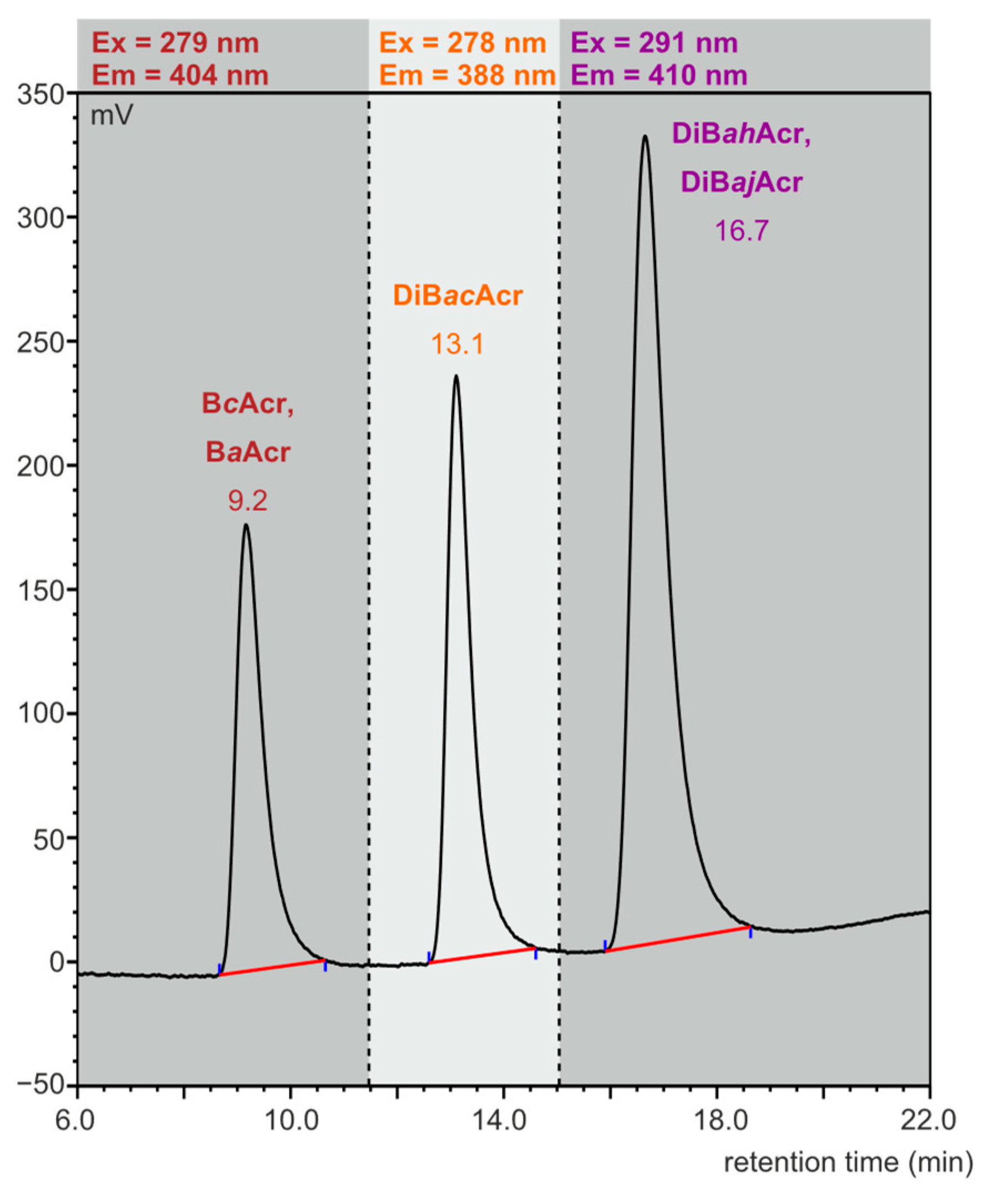
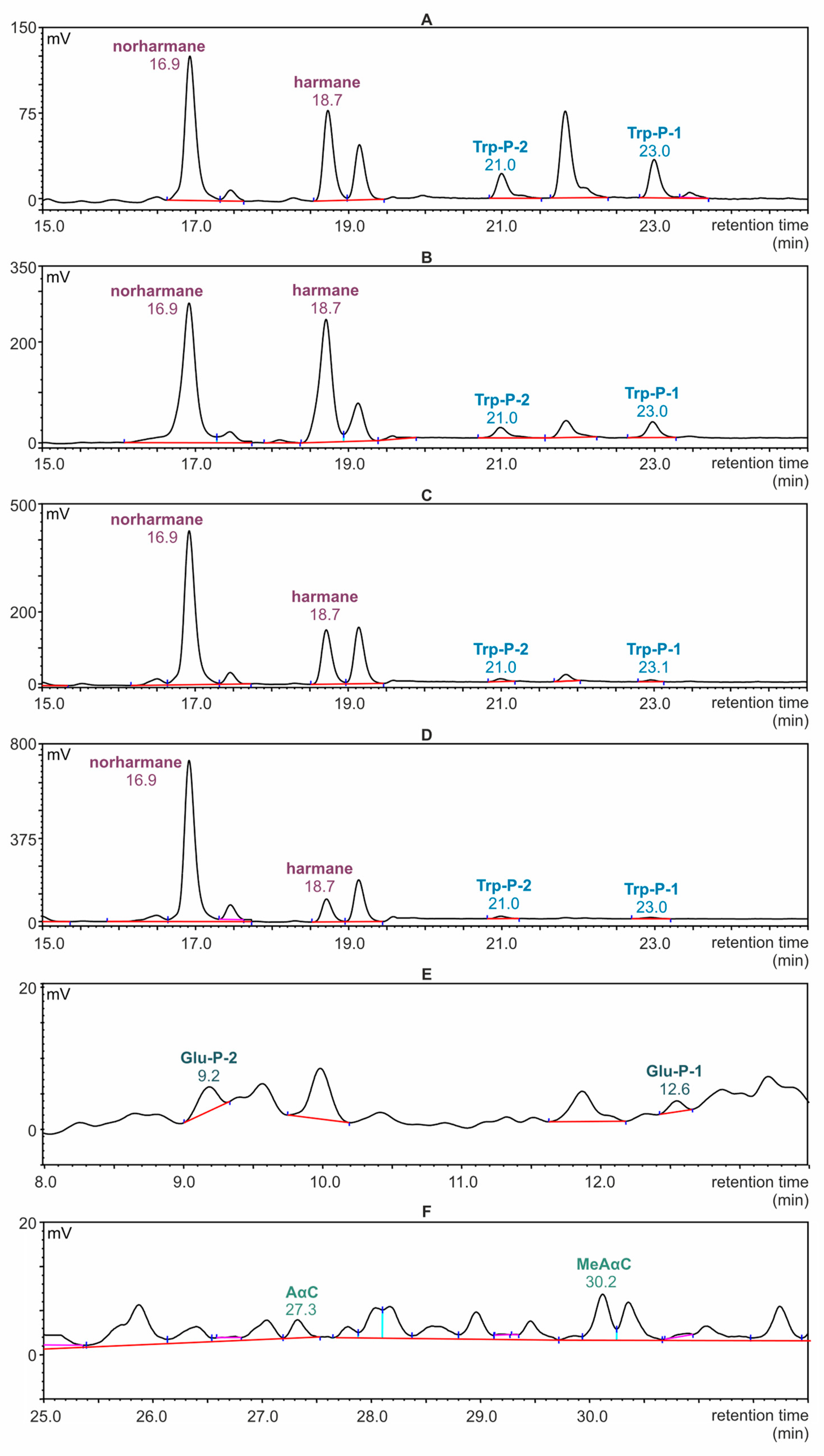
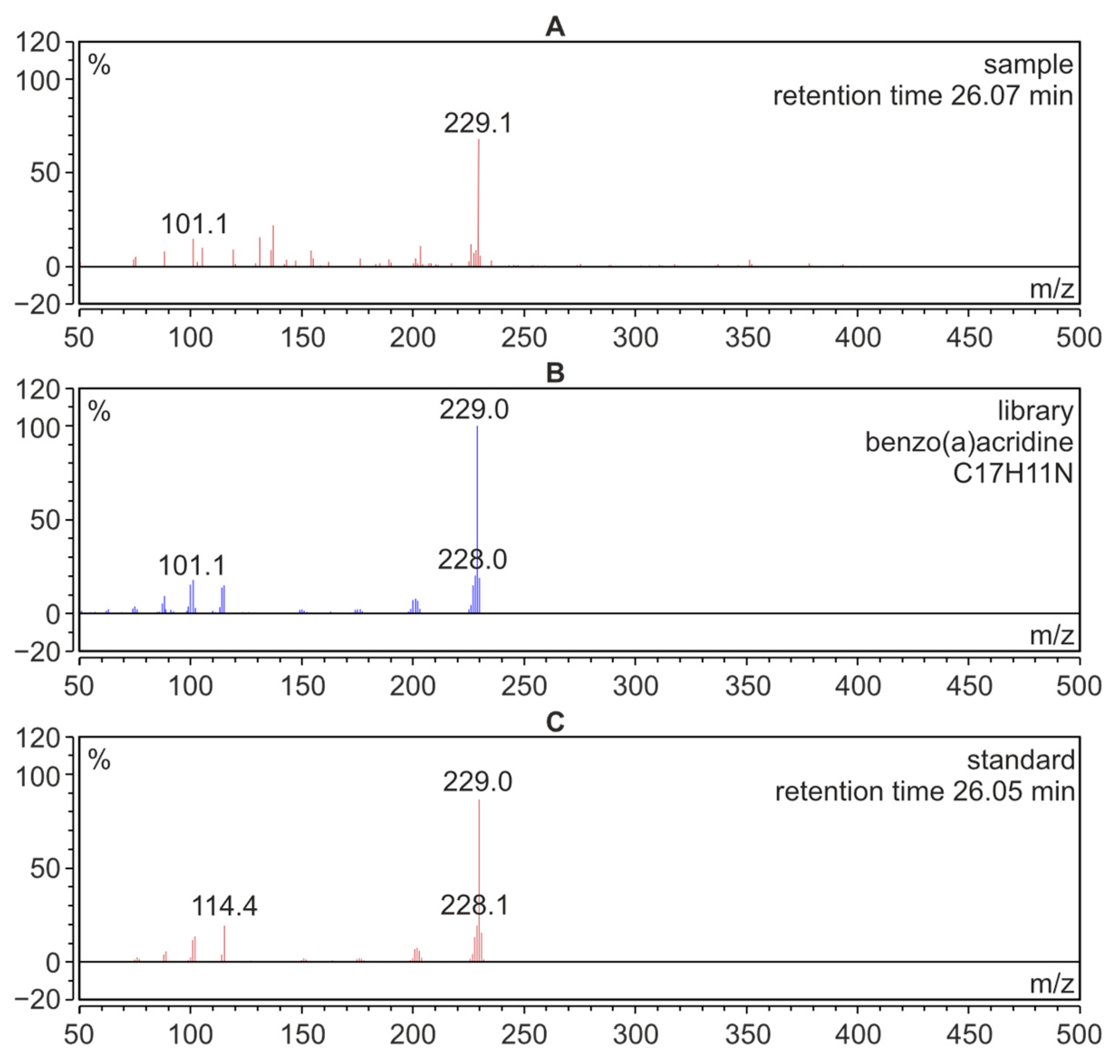
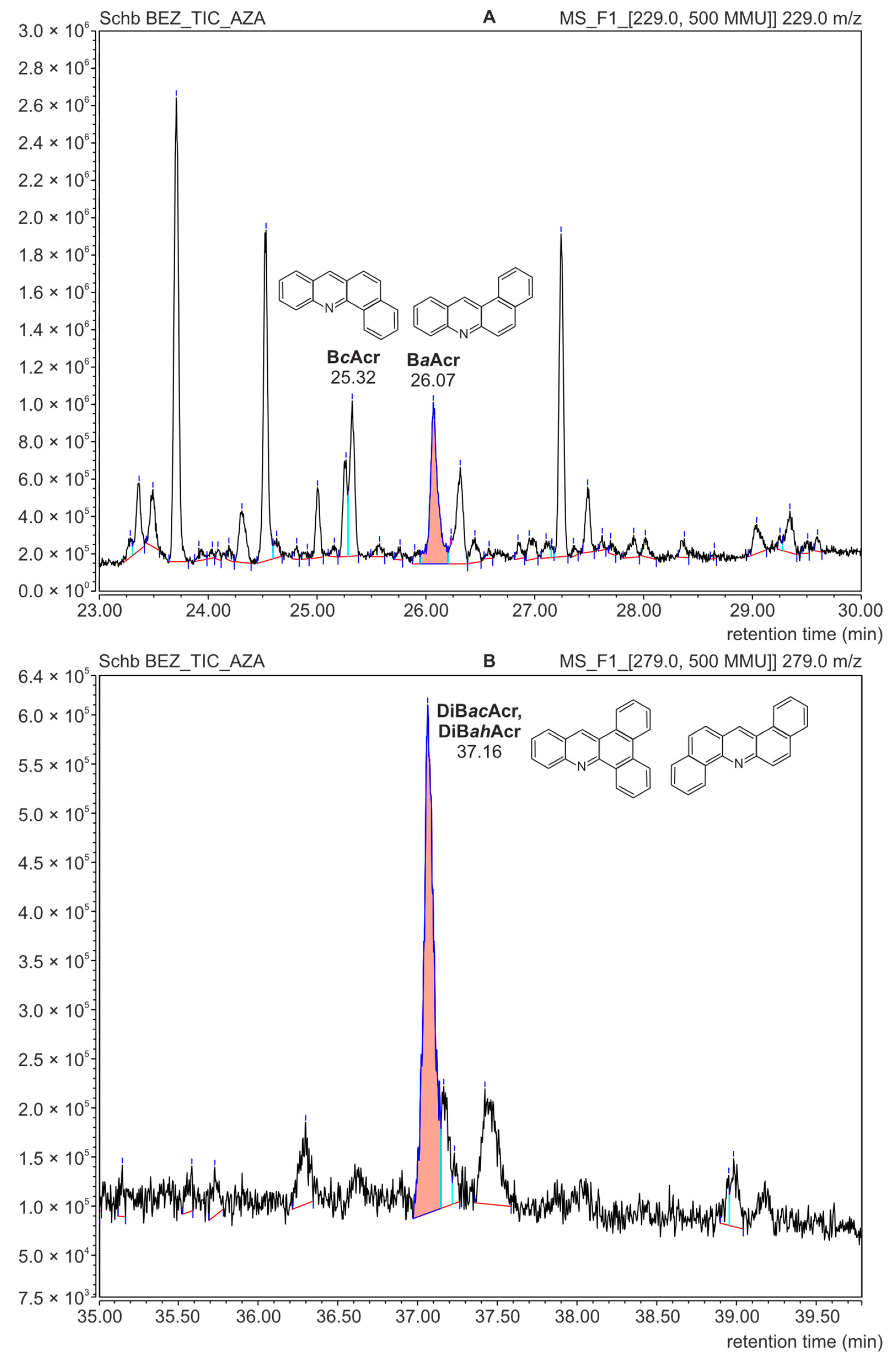
| Carboline | Abbreviation | Azaarene | Abbreviation |
|---|---|---|---|
| 2-Amino-9H-pyrido [2,3-b]indole | AαC | Benzo[a]acridine | BaAcr |
| 2-Amino-3-methyl-9H-pyrido [2,3-b]indole | MeAαC | Benzo[c]acridine | BcAcr |
| 9H-pyrido [3,4-b] indole | Norharmane | Dibenzo[a,c]acridine | DiBacAcr |
| 1-methyl-9H-pyrido [3,4-b]indole | Harmane | Dibenzo[a,h]acridine | DiBahAcr |
| 3-Amino-1-methyl-5H-pyrido [4,3-b]indole | Trp-P-2 | Dibenzo[a,j]acridine | DiBajAcr |
| 3-Amino-1,4-dimethyl-5H-pyrido [4,3-b]indole | Trp-P-1 | ||
| 2-Aminodipyrido [1,2-a:3’,2’-d]imidazole | Glu-P-2 | ||
| 2-Amino-6-methyldipyrido [1,2-a:3’,2’-d]imidazole | Glu-P-1 |
| Pork Loin Sample | Norharmane | Harmane | Total Content |
|---|---|---|---|
| Without additives | 2.16 ± 0.08 a | 1.00 ± 0.08 a | 3.16 |
| With prunes | 5.99 ± 0.23 b | 3.59 ± 0.09 b | 9.58 |
| With apricots | 7.42 ± 0.82 c | 1.83 ± 0.23 c | 9.25 |
| With cranberries | 12.32 ± 0.97 d | 1.20 ± 0.04 d | 13.52 |
| Recovery (%) of spiked standards (RSD 1, %); n = 9 | |||
| Spiking level: | |||
| 10 ng/g | 73.15 (8.2) | 78.47 (12.8) | |
| 40 ng/g | 74.36 (8.6) | 84.28 (4.6) | |
| Limit of quantification (ng/g of meat) | |||
| 0.10 | 0.18 | ||
| Pork LoinSample | Glu-P-2 | Glu-P-1 | AαC | MeAαC | Trp-P-1 | Trp-P-2 | Total Content (Inhibition %) |
|---|---|---|---|---|---|---|---|
| Without additives | 0.27 ± 0.04 a | 0.31 ± 0.02 a | 0.16 ± 0.03 | 0.21 ± 0.03 | 0.18 ± 0.01 a | 0.15 ± 0.01 a | 1.28 |
| With prunes | 0.11 ± 0.02 b | 0.11 ± 0.02 b | 0.16 ± 0.03 | n.q 1 | 0.03 ± 0.00 b | 0.02 ± 0.00 b | 0.43 (66.4) |
| With apricots | 0.16 ± 0.02 c | 0.12 ± 0.02 b | 0.13 ± 0.03 | n.q 1 | 0.09 ± 0.01 c | 0.04 ± 0.00 c | 0.54 (57.8) |
| With cranberries | 0.16 ± 0.03 c | 0.19 ± 0.04 c | 0.12 ± 0.03 | n.q 1 | 0.07 ± 0.01 c | 0.05 ± 0.01 d | 0.59 (53.9) |
| Recovery (%) of spiked standards (RSD 2, %); n = 9 | |||||||
| Spiking level: | |||||||
| 10 ng/g | 45.49 (5.8) | 43.46 (6.3) | 48.06 (11.6) | 43.76 (5.6) | 45.24 (7.6) | 58.0 (10.0) | |
| 40 ng/g | 46.04 (6.6) | 44.25 (5.1) | 47.67 (9.8) | 43.72 (9.6) | 47.93 (5.0) | 60.26 (8.3) | |
| Limit of quantification (ng/g of meat) | |||||||
| 0.1 | 0.05 | 0.05 | 0.10 | 0.03 | 0.01 | ||
| Pork Loin Sample | BcAcr + BaAcr 1 | DiBacAcr | DiBahAcr + DiBajAcr 2 | Total Content (Inhibition %) |
|---|---|---|---|---|
| Without additives | 0.068 ± 0.007 | 0.027 ± 0.003 | n.q 3 | 0.095 |
| With prunes | 0.021 ± 0.003 | 0.023 ± 0.003 | n.q 3 | 0.044 (53.68) |
| With apricots | 0.066 ± 0.009 | 0.018 ± 0.002 | n.q 3 | 0.084 (11.58) |
| With cranberries | n.q 3 | n.q 3 | n.q 3 | n.q 3 |
| Recovery (%) of spiked standards (RSD 4, %); n = 9 | ||||
| Spiking level: | BcAcr | DiBacAcr | DiBahAcr | |
| 10 ng/g | 65.87 (8.2) | 65.69 (11.0) | 66.83 (13.2) | |
| 40 ng/g | 71.93 (12.6) | 69.46 (16.3) | 66.77 (15.5) | |
| Limit of quantification (ng/g of meat) | ||||
| 0.01 | 0.01 | 0.006 | ||
Publisher’s Note: MDPI stays neutral with regard to jurisdictional claims in published maps and institutional affiliations. |
© 2022 by the authors. Licensee MDPI, Basel, Switzerland. This article is an open access article distributed under the terms and conditions of the Creative Commons Attribution (CC BY) license (https://creativecommons.org/licenses/by/4.0/).
Share and Cite
Śnieżek, E.; Szumska, M.; Nowak, A.; Muzyka, R.; Janoszka, B. Application of High-Performance Liquid Chromatography with Fluorescence Detection for Non-Polar Heterocyclic Aromatic Amines and Acridine Derivatives Determination in Pork Loin Roasted in a Roasting Bag. Foods 2022, 11, 3385. https://doi.org/10.3390/foods11213385
Śnieżek E, Szumska M, Nowak A, Muzyka R, Janoszka B. Application of High-Performance Liquid Chromatography with Fluorescence Detection for Non-Polar Heterocyclic Aromatic Amines and Acridine Derivatives Determination in Pork Loin Roasted in a Roasting Bag. Foods. 2022; 11(21):3385. https://doi.org/10.3390/foods11213385
Chicago/Turabian StyleŚnieżek, Ewa, Magdalena Szumska, Agnieszka Nowak, Roksana Muzyka, and Beata Janoszka. 2022. "Application of High-Performance Liquid Chromatography with Fluorescence Detection for Non-Polar Heterocyclic Aromatic Amines and Acridine Derivatives Determination in Pork Loin Roasted in a Roasting Bag" Foods 11, no. 21: 3385. https://doi.org/10.3390/foods11213385
APA StyleŚnieżek, E., Szumska, M., Nowak, A., Muzyka, R., & Janoszka, B. (2022). Application of High-Performance Liquid Chromatography with Fluorescence Detection for Non-Polar Heterocyclic Aromatic Amines and Acridine Derivatives Determination in Pork Loin Roasted in a Roasting Bag. Foods, 11(21), 3385. https://doi.org/10.3390/foods11213385







